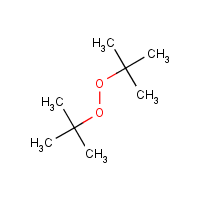Di-tert-butyl peroxide
Agent Name
Di-tert-butyl peroxide
Alternative Name
Bis(1,1-dimethylethyl)peroxide
CAS Number
110-05-4
Formula
C8-H18-O2
Major Category
Other Classes

Synonyms
Bis(1,1-dimethylethyl)peroxide; Bis(t-butyl)peroxide; Bis(tert-butyl) peroxide; Cadox; Cadox TBP; DTBP; Di-t-butyl peroxide; Di-tert-Butyl hydroperoxide; Di-tert-butyl peroxyde [Dutch]; Di-tert-butylperoxid [German]; Interox DTB; Kayabutyl D; Perbutyl D; Perossido di butile terziario [Italian]; Peroxide, bis(1,1-dimethylethyl); Peroxyde de butyle tertiaire [French]; Trigonox B; t-Butyl peroxide; tert-Butyl peroxide; [ChemIDplus] UN3107
Category
Peroxides, Organic
Description
Clear, water-white or yellow liquid; Insoluble in water; [HSDB] Faintly yellow clear liquid; Insoluble in water; [MSDSonline]
Sources/Uses
Used as an initiator for high-temperature, high-pressure polymerizations of ethylene and halogenated ethylenes; in the synthesis of polyketones; as a finishing catalyst for polystyrene; as a polymerization catalyst for acrylonitrile polymers and resins (including olefins, styrene, styrenated alkyds, and silicones); as curing agent for styrenated alkyds and silicone rubbers; as ignition accelerator for diesel fuels; and as a cross-linking agent (rubber and resins); [HSDB]
Comments
Caused muscle weakness and ataxia after intraperitoneal lethal-dose studies of rats; Mild irritant effect when administered into eyes of rabbits; [RTECS] Fire hazard; Strong oxidizer; [Hawley] A skin and mucous membrane irritant; Corrosive to eyes; [HSDB] An eye and respiratory tract irritant; [ICSC] May cause irritation; [MSDSonline]
Biomedical References
Exposure Assessment
Vapor Pressure
25.1 mm Hg
Lethal Concentration
LC50 (rat) > 4,100 ppm/4h
Explanatory Notes
The Guide in the Emergency Response Guidebook is for "Oragnic peroxide type E, liquid." VP from ChemIDplus;
NFPA
high ambient temp required
Diseases, Processes, and Activities Linked to This Agent
Processes
Industrial Processes with risk of exposure: